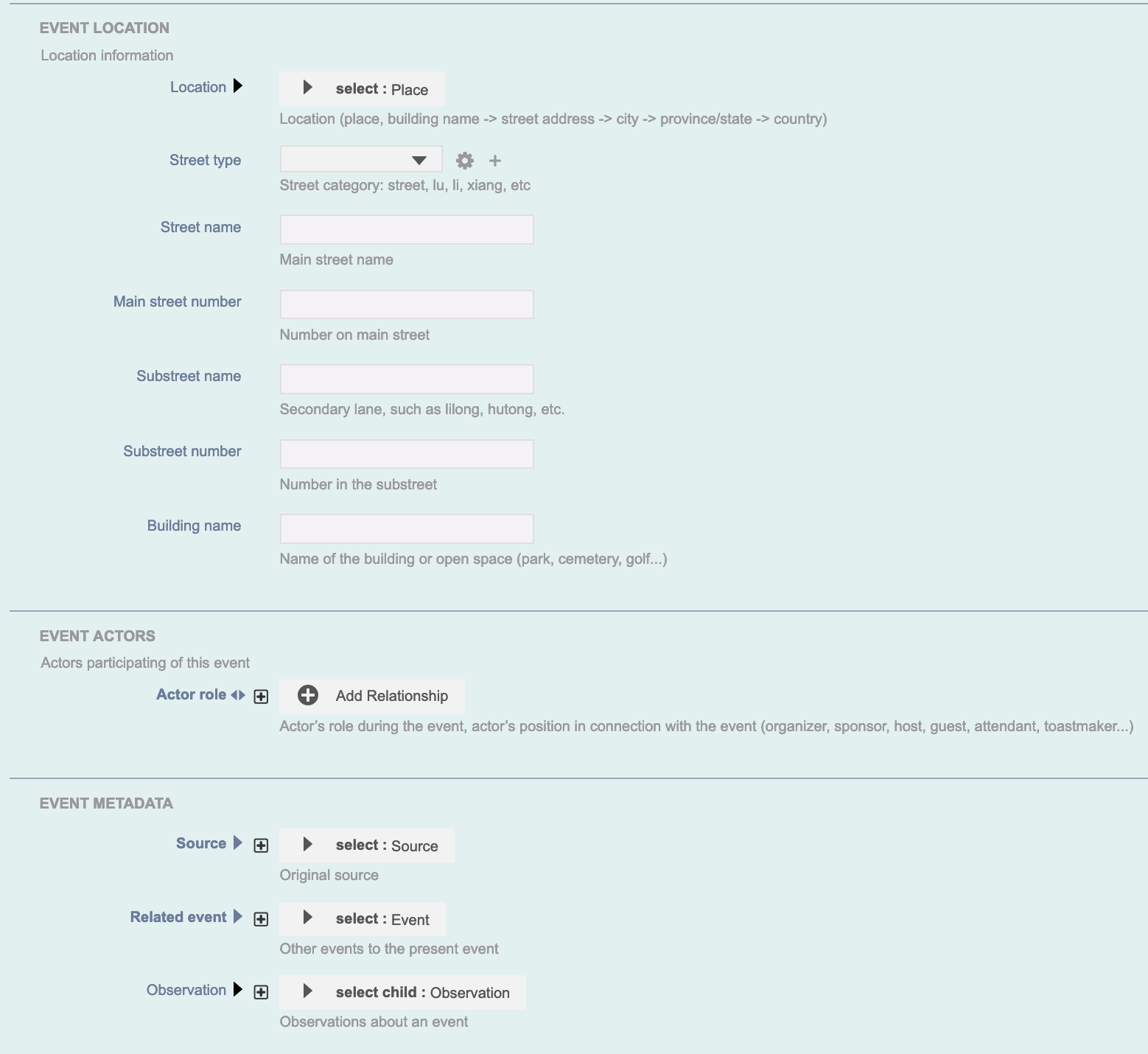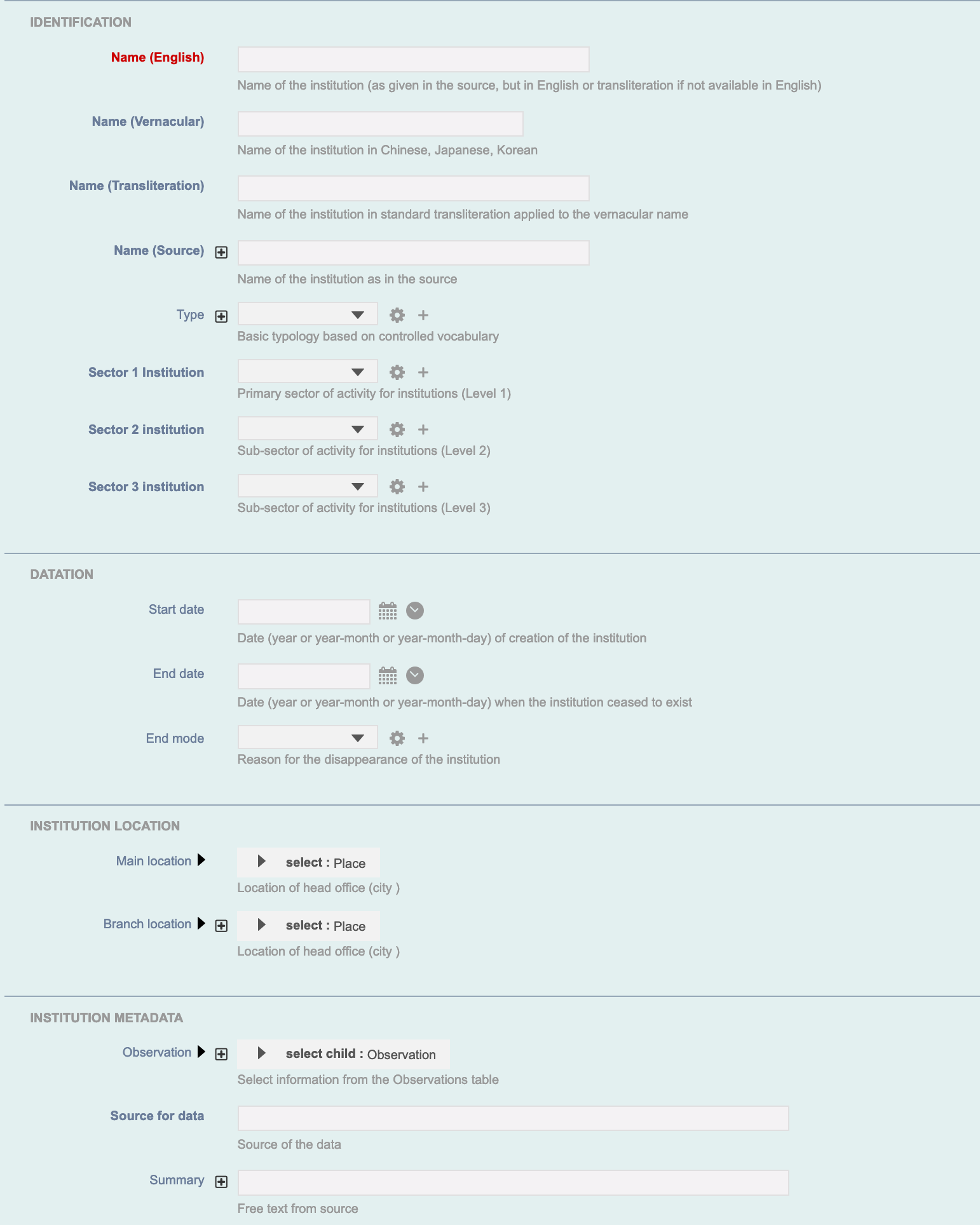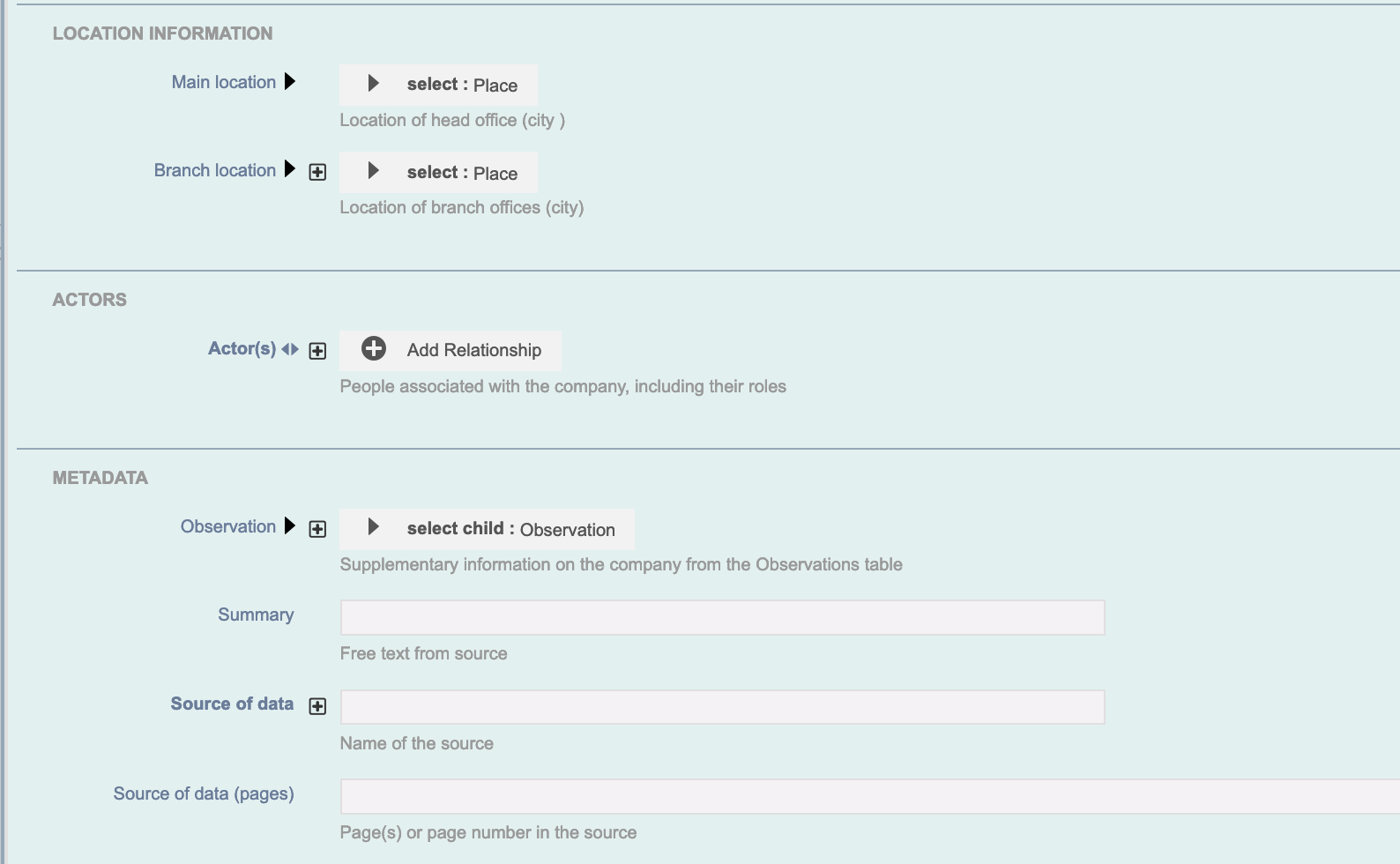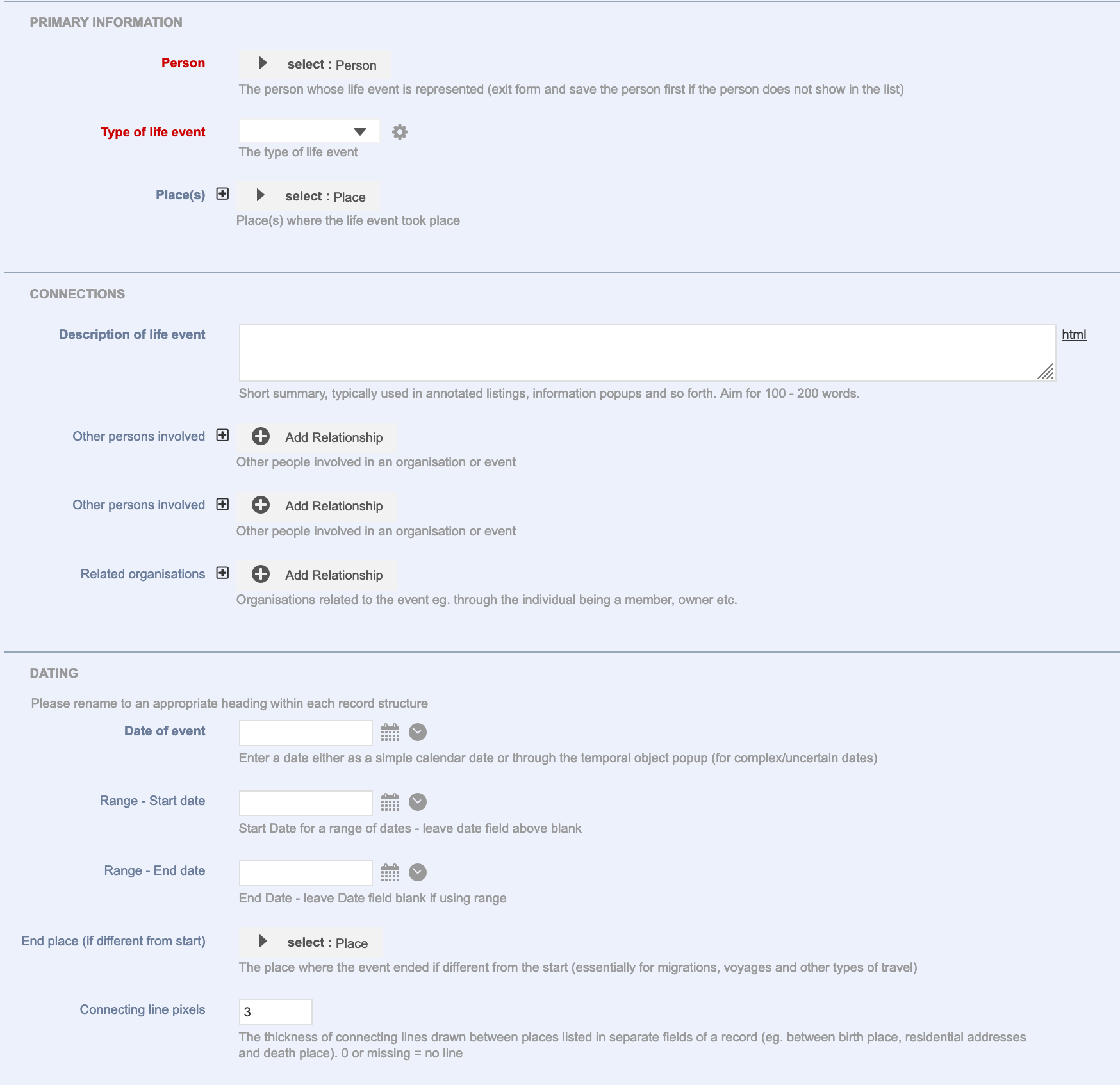2 Tables
In the following section, we present the eleven tables that form the main data container of MCBD. We describe the purpose and organization of each table and provide a description of all their fields.
2.1 Person
The Person table constitutes the core element that connects all the other tables in the database. It is composed of nine sections:
- Naming
- Additional information
- Birth
- Death
- Professional and social life
- Personal life
- Events
- Metadata
- Visual data
2.1.1 Naming and Additional Information
The “Naming” section provide the basic information for the identification of individuals, namely the canonical name (Surname + Given Name) and the different variations of the names under which the individual was known in the course of his/her life and in the various sources that document the life of the individual. In the case of Chinese, they may have different Chinese names, usually alternative given names, courtesy names (字) , style name (號), not to mention pen names, stage names, etc. They could also be known through their name in transliteration that, before the advent of pinyin, could take many forms.
The “Additional Information” section provides supplementary elements about the quality of the person such as nationality, ethnicity, ancestral native place, language skills, and titles.

Fig. 2. The Naming and Additional Information sections
2.1.2 Fields for Naming
| Field | Description |
|---|---|
| ID_db_source | This is an identifier created for the import |
| Fullname | Fullname in vernacular |
| Surname | Family name of person |
| Surname - vernacular | Surname in vernacular language |
| Given name(s) | The given name or names of the person, placed in their normal order |
| Given name(s) - vernacular | Given name in vernacular language |
| Alternative name(s) | Individual’s alternative name in different sources |
| Transliteration Name | Transliteration of non-Chinese name (foreigner) in Chinese |
| Zi 字 | Courtesy name (字) |
| Hao 號 | Style name(號) |
| Gender | Male/Female |
2.1.3 Fields for Additional Information
| Field | Description | |
|---|---|---|
| Jiguan 籍貫 | Ancestral native province (not where someone was born, but where his/her ancestors were born) | |
| Ethnicity | Ethnic group (Mongol, Miao, Kejia, Han, etc.) | |
| Language skill | Any language skill of the person (non-Chinese languages, Chinese dialects) | |
| Nationality | Nationality (official national citizenship) | |
| Honorific | Any title or grade - Prof, Dr, Sir, M.C.G.D., etc., but we recommend omitting Mr., Mrs. or Ms. | |
| Representative picture | Thumbnail image used to represent the person (eg. portrait photo), up to 400 pixels wide, for display normally 100 - 200 pixels wide in search results, lists and reports | |
| Short description | Short description of the person for use in annotated lists/web pages (100 - 200 words). | |
| Related Person(s) | People related to the person by birth, marriage or other relationships |
2.1.4 Birth and Death
The “Birth” and “Death” sections indicate the dates and locations of birth and death. The location can be recorded as a textual reference in the following format “Beijing – 北京”), but it should preferably be recorded as a geolocation linked to the Modern China Geospatial Database. The linkage between MCGD and MCBD is done through a system of unique IDs. To retrieve the location IDs (LID), we provide an dedicated interface with the possibility to upload a list of place names and obtain all the related data.

Fig. 3. The Birth and Death sections
2.1.5 Fields for Birth and Death
| Birth | |
|---|---|
| Field | Description |
| Date of birth | Date of Birth (year or year-month or year-month-day) |
| Place of birth | Place of birth expressed as a location (place) record |
| Birth place (textual) | Name of the location where the person was born in free text (rule: “New York,”Beijing - 北京“,”Jiangjin xian, Zhejiang - 浙江浙江鄞縣" |
| Province of birth | Name of the province of birth as indicated in the source, in the following format: pinyin - Chinese (e.g., Hunan - 湖南) |
| Country of birth | The list is prepopulated, but can be extended, and includes two- and three-letter country codes |
| Note on Date of birth, | if alternative date of birth or precision is needed. |
| Death | |
| Field | Description |
| Date of death | Date of death (year, or year-month or year-month-day) |
| Death Place | Select the location in the Geospatial database |
| Death place (textual) | Name of the location where the person died in free text (rule: “New York,” “Beijing 北京,” “Jiangjin xian, Zhejiang 浙江鄞縣”) |
| Country of death | The country in which the person died |
| Cause of death | The cause of death, if known/applicable |
2.3 Personal life
The “Personal life” section documents two major elements: religious affiliation(s) and kinship (marriage, spouse(s), and other relatives).

Fig. 8. The Personal Life section
2.3.1 Fields for Personal Life
| Field | Description | |
|---|---|---|
| Religious affiliation(s) | Religious creed of the person (Christian, Catholic, Buddhist, etc.) (click to add a religious creed) | |
| Marriage(s) | Information of any form of formal marital relationship (click to connect to the “Marriage” table) | |
| Other spouse | Other spouse, concubines | |
| Relative(s) | Relative’s name |
2.3.2 Child records : Religious affiliation
The rapid transformation of religious groups (Buddhist, Daoist, Christian associations, and redemptive societies) as well as the evolution of the concept of superstition in Republican and Communist China, has not only shaped the dynamics on the daily life of modern Chinese elites, but also exerted a profound influence on their involvement in the value systems of identities, cultures, or politics.

Fig. 9. The Religious affiliation section
2.3.3 Fields for Religious affiliation
| Field name | Description | |
|---|---|---|
| Religion | Religious creed (eg. Buddhism, Daoism, Christianity, redemptive societies) | |
| Rite/ Ritual performed | The type of rite performed (temple festivals, spirit-writing, sacraments, philanthropic activities, publication, build schools with temple property movement) | |
| Rite/ Ritual: date | Date when the rite was received (1927, 1932, 1933) | |
| Rite/ Ritual: location | Location where the rite was received ( Beijing, Tianjin, Shanghai, Guangzhou, Hongkong) | |
| Metadata | ||
| Source | Original source (source_id., keyword, abbreviation) |
2.3.4 Child records : Marriage(s)
The Marriage(s) section records the formal marital relations between individuals. Marriage is understood here as a formal bond within men and women, regardless of the various forms that such a bond can take (“first wife,” concubine, etc.). This does not include liaisons, affairs and all other forms of romantic relationships.

Fig. 10. The Marriage(s) section
2.3.5 Fields for Marriage(s)
| Field | Description | |
|---|---|---|
| Marital status | Status: married, single | |
| Spouse | Main spouse | |
| Wedding: location | Location where the marriage took place | |
| Start date | Marriage date | |
| End date | Date when the marriage ended | |
| End mode | Mode : divorce, separation, death, etc. | |
| Marriage type | Type of marriage : religious (Catholic, Protestant) or not (secular) | |
| Wedding | General event associated to this marriage | |
| Metadata | ||
| Sources | Bibliographical references | |
2.3.6 Relationship: Other spouse(s)
This is a pointer field from which to select a person in the Person table. The person to be selected must already have been created in the Person table.

Fig. 11 The Other spouse(s) section
2.3.7 Relationship: Relative(s)
This is a pointer field from which to select a person in the Person table. The person to be selected must already have been created in the Person table.

Fig. 12 The Other spouse(s) section
2.4 Events
The “Events” section records all the events that happened in the life of the individual, with basic information such as name of the event, dates, location, and participants.

Fig. 13. The Events section
2.4.1 Fields for Events
| Event Identification | |
|---|---|
| Field name | Description |
| Label | Name of event (as given in the original source) |
| Type | Type of event, based on controlled vocabulary |
2.4.2 Event Identification and Datation
The “Events” table records all sorts of social or personal events (meetings, weddings, funerals, etc.) in which individuals or organizations were involved.

Fig. 14a. The Event information section
2.4.3 Fields for Event Identification and Datation
| Event Identification | |
|---|---|
| Field name | Description |
| Label | Name of event (as given in the original source) |
| Type | Type of event, based on controlled vocabulary |
| Event Datation | ||
|---|---|---|
| Field name | Description | Additional information |
| Start Date | Date when the event started (YYYY-MM-DD) | Select a date in the calendar or enter the date manually (YYYY-MM-DD) |
| End Date | Date when the event ended (YYYY-MM-DD) | Select a date in the calendar or enter the date manually (YYYY-MM-DD) |
| Start Time | Time when the event started (hour, minute) | |
| End Time | Time when the event ended (hour, minute) | |
| Temporal marker | Moment during the day (morning, noon/lunch, afternoon, evening, night…) | |
2.4.4 Event Location and Actors

Fig. 14b. The Event information section
In the Location section, the denomination of the road needs to be defined from the scrolling menu (street, avenue, boulevard, square, 路, 廣場, etc.). The field for street name should include only the proper name of the road (Adam Smith, Confucius, Château, 南京, 吉祥, 共和, etc.), without any suffix. For buildings, the name shall be as indicated in the source.
2.4.5 Fields for Event Location and Actors
| Event Location | ||
|---|---|---|
| Field name | Description | Additional information |
| Location information | Location (place -> building name -> street address -> city -> province/state -> country) | Select a place in the geospatial database |
| Street Name | Main street name | |
| Street Number | Main street number | |
| Substreet Name | Secondary lane, such as lilong, hutong, etc. | |
| Substreet Number | Number in the substreet | |
| Building name | Name of the building or open space (park, cemetery, golf…) | |
| Event Actors | ||
| Field name | Description | Additional information |
| Actors participating in this event | Select a person or organization in the database | |
| Role | Actor’s role during the event, his/her position in connection with the event, based on controlled vocabulary | Add a relationship, select the role in the list |
| Event Metadata | ||
| Field name | Description | Additional information |
| Source | Original source for the event | Select the id of the source |
| Related event | Other events related to this event | Select the event in the database |
| Observation | Observations about an event | Select a record in the “Observation” table |
2.4.6 Observation(s)
The Observations field is an essential component of MCBD. Whereas all other fields contain a single and unique item of data (date, name, etc.), the Observations field collects whole sentences (or part of a sentence). The reason for this field is to enable the collection of information extracted from sources from two perspectives: first, it provides the elements of data in context (a whole sentence); second, it collects information that may be curated at a later stage, either as split-up data that goes in a specific field or as a curated and validated informative sentence. This is designed to address two distinct issues:
First, as “information in context,” we drew our inspiration from Jean-Pierre Dedieu’s Fichoz database system that records “actions,” namely any event associated to an individual in the form of text. Historical information does not always lend itself to being boiled down to tabular data. Historians need to record such information in a format that retains most of the information in a form that reflects as closely as possible the information in the source. It can be seen as a form of note-taking, but it actually fits in-between note-taking and tabular data. This is information already transformed and streamlined by the historian. In MCBD, such streamlined and curated information is transformed from the Observations_Raw field to the Observations_Validated field.
Second, thanks to the use of digital tools, especially Natural Language Processing algorithms, it is possible to retrieve a lot of information on any individual in a source. This produces a volume of information that it is beyond the ability of anyone to process systematically. Such processing into data or validated information will make sense only in relation to research on a case study or to extract specific data. The collection of such “raw information,” however, presents us with two major benefits: first, all the information that relates to an individual is gathered in one place, it becomes associated to this individual, and it expands the biographical information on the individual; second, the information collected in the Observations Raw field constitutes a subset of information that can easily be extracted and re-processed for data extraction.

Fig. 15. The Observations section
2.4.7 Fields for Observation(s)
| Field | Description |
|---|---|
| Observation: raw | Additional action/event information (non atomized data) |
| Observation: validated | Qualitative curated content |
| Link to source | Direct link to text, preferably to line in paragraph in original source (e.g. SolR, Freizo) |
| Source URL | URL of source document |
| Date | Date of observation |
| Related Data Source | Link to other databases through link (e.g. 近現代人物資訊整合系統) |
| Field | Description |
| Crowdsourcing | |
| Crowdsourcing comments | Information provided through crowdsourcing on a given observation |
2.4.8 Metadata and Visual data
The “Metadata” section serves to record strictly the documentary source(s) from which the information was drawn. The metadata field is the only field to be found in all the tables. All the other fields are unique to each table and do not overlap.
If the data originate from a third party (person, group, institution, project, resource, etc.), this is recorded in the Provenance field (and whenever relevant with the indication of the web page (URL) of the third party. This does not record the Source, but only the Provenance.`
The Source(s) and Provenance fields are repeated fields. They do not point to a single resource, but to all the resources that contributed to the information in the Person table.
The “Visual data” section provides the possibility to associate and document any element of visual data (any type of fixed or moving image).

Fig. 16. The Metadata and Visual data sections
2.4.9 Fields for Metadata and Visual data
| Metadata | |
|---|---|
| Field | Description |
| Sources for Person | Source of the data (full bibliographical reference and page number when relevant) |
| Source URL | URL to source document |
| Provenance |
Name of the person, group, resource that provided the data |
| Provenance URL |
URL of the person, group, resource that provided the data |
| Visual data | |
| Field | Description |
| Multimedia | Points to a multimedia record, image etc. |
2.5 Secondary records
2.5.1 Child records : Institutions – Institutions
The Institution table is a secondary table for Persons. It records all the information on all types of institutions, except companies for which a distinct table exists. Although the term “Institution” could include companies, we made the choice to have two separate tables because the nature and degree of completeness of the information vary greatly. Moreover, very specific date may often be asssociated to companies that have no relevance for other institutions (such as capital, workforce, products, etc.).

Fig. 17. The Institutions section
2.5.2 Fields for Institutions
| Field | Description |
|---|---|
| Name (English) | Name of the institution (as given in the source, but in English or transliteration if not available in English) |
| Name (Vernacular) | Name of the institution in Chinese, Japanese, Korean |
| Name (Transliteration) | Name of the institution in standard transliteration applied to the vernacular name |
| Name (Source) | Name of the institution as in the source |
| Type | Basic typology based on controlled vocabulary |
| Sector 1 Institution | Primary sector of activiy for institutions (Level 1) |
| Sector 2 institution | Sub-sector of activity for institutions (Level 2) |
| Sector 3 institution | Sub-sector of activity for institutions (Level 3) |
| Datation | |
| Start date | Date (year or year-month or year-month-day) of creation of the institution |
| End date | Date (year or year-month or year-month-day) when the institution ceased to exist |
| End mode | Reason for the disappearance of the institution |
| Institution Location | |
| Main location | Location of head office (city: ) |
| Branch location | Location of branch offices |
2.5.3 Child records : Institutions – Company
The Company table is designed to record data on public or private business companies.

Fig. 18. The Company section
2.5.4 Fields for Company 1
| Identification | |
|---|---|
| Field | Description |
| Name (English) | Name of the institution (as given in the source, but in English or transliteration if not available in English) |
| Name (Vernacular) | Name of the institution in Chinese, Japanese, Korean |
| Name (Transliteration) | Name of the institution in standard transliteration applied to the vernacular name |
| Name (Source) | Name of the institution as in the source |
| Related company | List of names of twin companies: companies that changed name and/or status (e.g. Tsinghua College, Tsinghua University) |
| Typology | |
| Type | Basic typology based on controlled vocabulary |
| Sector 1 | Primary sector of activiy for companies (Level 1) |
| Sector 2 | Sub-sector of activity for companies (Level 2) |
| Sector 3 | Sub-sector of activity for companies (Level 3) |
| Datation | |
| Start date | Date (year or year-month or year-month-day) of creation of the institution |
| End date | Date (year or year-month or year-month-day) when the institution ceased to exist |
| End mode | Reason for the disappearance of the institution |

Fig. 19. The Company section
2.5.5 Fields for Company 2
| Main location | ||
|---|---|---|
| Main location | Location of head office (city ) | Select location from geodatabase |
| Branch location | Location of branch offices (city) | Select location from geodatabase |
| Actors | ||
| Actor(s) | People associated with the company, including their roles | |
| Metadata | ||
| Observation | Observations about a company | |
| Summary | Free text from source | |
| Source of data | The name of the source where data where found | |
| Source of data (pages) | Page(s) or page number in the source. | |
2.5.6 Child records : Company statistics
This table is devoted to recording operational data about the company, such as workforce, capital, production, etc.

Fig. 20 The Company Statistics section
2.5.7 Fields for Company statistics
| Identification | |
|---|---|
| Date of company info | Date (year or year-month or year-month-day) the organisation was established |
| Name of company - vernacular | The name of the company |
| Staff | |
| Workforce | Integer |
| Company info | |
| Capital | Integer |
| Currency (English) | Name of currency |
| Currency (Vernacular) | Name of currency in vernacular language |
| Currency (Source) | Name of currency as in source |
| Inventory and Operations | |
| Inventory | Integer |
| Unit (Inventory) | Name of unit of count |
| Production | Integer |
| Unit (Production) | Name of unit of count |
| Profit/Loss | Integer (+ or -) |
| Turnover | Integer |
| Metadata | |
| Observation | Observations about a company |
| Summary | Free text from source |
| Source of data | The name of the source where data where found |
| Source of data (pages) | Page(s) or page number in the source. |



